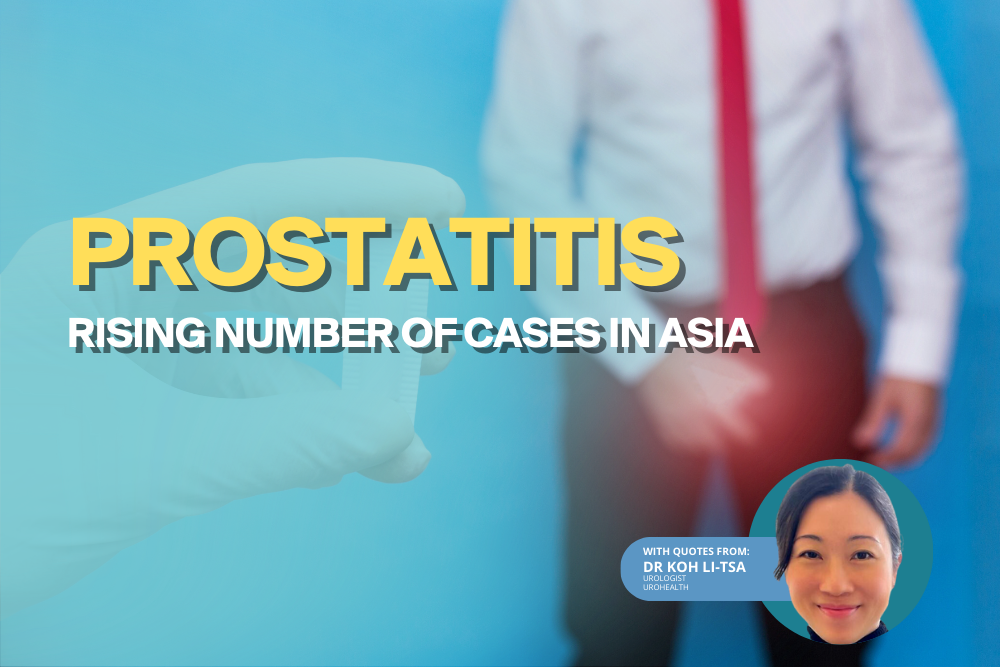Recent medical studies across Asia have revealed an alarming increase in prostatitis cases, drawing attention to a significant yet often overlooked men’s health issue.
This trend not only raises concerns about individual health but also highlights larger public health implications. We learn more about this condition with Dr Koh Li-Tsa. Dr Koh Li-Tsa is a Senior Consultant Urology with Urohealth Medical Clinic. She specialises in the treatment of urinary incontinence, overactive bladder, nocturia, urinary stones, urinary tract infections, bladder and prostate diseases as well as men’s health issues.
Understanding Prostatitis
Prostatitis, the inflammation of the prostate gland, affects a substantial portion of the male population, especially in their middle ages. It’s a condition that hampers both urinary and sexual functions.
Dr Koh classifies prostatitis into four types. They are:
Acute bacterial prostatitis: This happens when bacteria enter the urinary tract and into the prostate, causing infection and inflammation of the gland. Acute infections happen suddenly and will resolve with antibiotics.
Chronic bacterial prostatitis: Bacteria may continue to reside within the prostate gland for certain men, causing long drawn and recurrent infections.
Chronic pelvic pain syndrome, or CPPS: CPPS is the most common prostatitis type. The exact cause is not known and is postulated to be caused by organisms causing long-standing inflammation of the gland and the surrounding tissues. This condition causes chronic pain in the pelvis, perineum (the area between the scrotum and rectum) and genitals.
Asymptomatic inflammatory prostatitis: This condition causes prostate gland inflammation but no symptoms and does not require treatment. This diagnosis is usually made after obtaining tissue from a biopsy or surgery for a separate prostate condition.
The Asian Scenario
In Asia, the surge in prostatitis cases has become a topic of concern for healthcare professionals. For instance, a recent Indian study indicated a 30% increase in reported cases over the last five years. China and Japan report similar trends, with Southeast Asia not far behind. This rise is not just a statistical anomaly but a signal to a deeper, widespread health issue.
Lifestyle and Diet Factors
Lifestyle changes, particularly in urban areas, play a significant role in this increase. The shift towards a more sedentary lifestyle, high levels of stress, and diets rich in processed foods are contributing factors. These elements, combined with environmental and genetic factors, create a complex web of causes that are difficult to unravel.
Symptoms and Diagnosis
Dr Koh stated, “The symptoms of prostatitis depend on the type of prostatitis as mentioned above. Acute bacterial prostatitis can cause fever, pain in urination, pain in the pelvic region, urgency and frequency of urination, chills and rigours. Chronic prostatitis may give rise to a long-standing ache in the perineum. It is usually diagnosed with examination of the prostate through a digital rectal examination, blood tests and urine tests.”
Treatment and Management
The approach to treating prostatitis depends on the type. Bacterial forms are typically treated with antibiotics, while non-bacterial types might require a combination of medications, lifestyle adjustments, and even physical therapy. Awareness of the condition and regular health screenings are critical for managing and potentially mitigating its impact.
Preventative Measures
Preventive strategies involve adopting a healthier lifestyle: regular exercise, a balanced diet, and minimizing stress. Additionally, avoiding prolonged periods of sitting, staying hydrated, and maintaining good personal hygiene are simple yet effective measures.
The Need for Awareness
Despite its prevalence, prostatitis is not widely understood in many Asian cultures, partly due to social taboos surrounding men’s health issues. This lack of awareness often leads to delayed diagnosis and treatment. Educational campaigns and greater public discourse are essential to change this narrative.
The Future Outlook
The increasing cases of prostatitis in Asia are a call to action for both healthcare providers and the public. With ongoing research, better diagnostic tools, and more comprehensive treatment options, there is hope for improved management and understanding of this condition. Collaborative efforts between government health agencies, medical communities, and public health initiatives are crucial to address this growing concern effectively.
Conclusion
The rising trend of prostatitis in Asia underscores the need for heightened awareness, improved medical infrastructure, and lifestyle changes. By tackling this issue head-on, there’s a significant opportunity to improve the health and well-being of a large segment of the population, ultimately leading to healthier communities across the continent.














